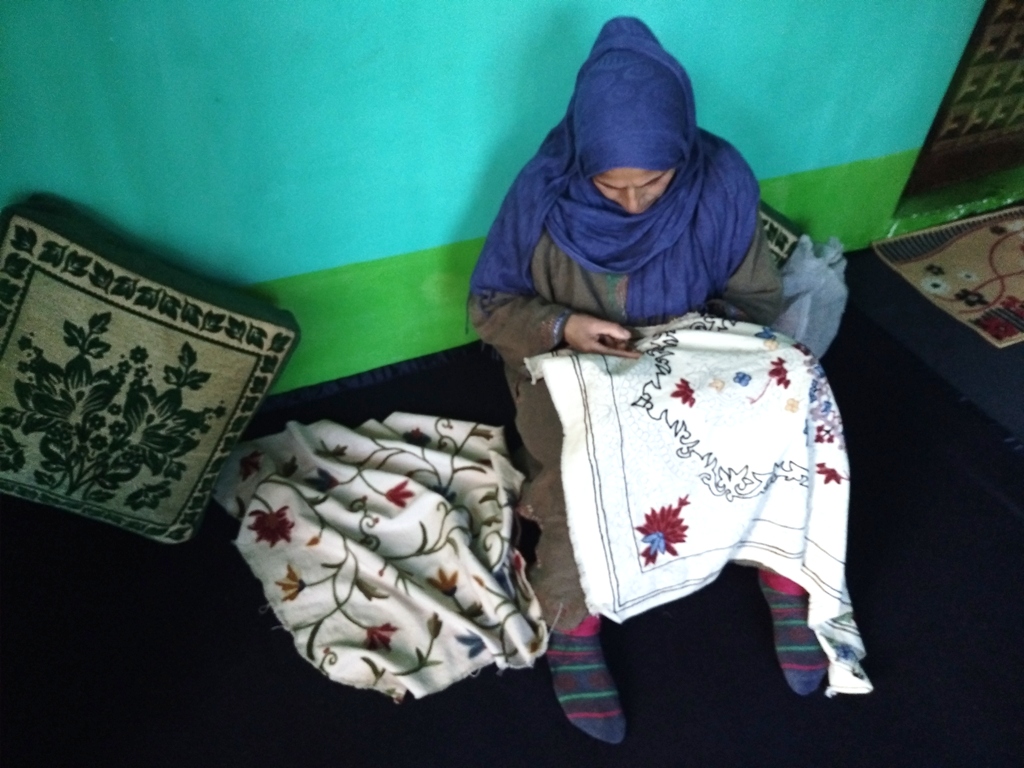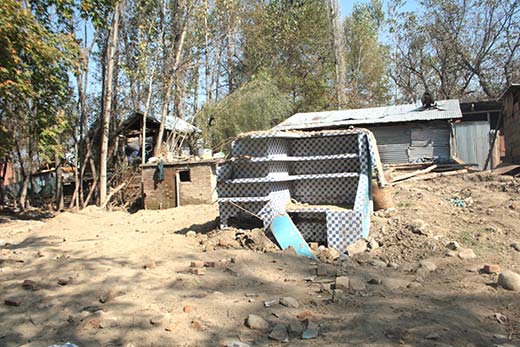Dilshada earned livelihood selling her work at exhibitions outside Jammu and Kashmir. But she lost everything to 2014 floods. Before she could pick up the threads, her husband was diagnosed with a brain tumour, reports Samreena Nazir

In September 2014, when the floods inundated large swathes of Kashmir, forcing people to seek safe shelters, Dilshada, 45, along with her family of seven, made a truck their home for a month. When she returned home, she could barely trace it as the Jhelum had taken almost everything along. Then, she rushed towards her nearby under-construction house but found a heap of slush there.
“The flood had washed away everything we had,” Dilshada said. “Yet, we were happy that we escaped alive.”
Dilshada’s Aarigatno village in Kulgam was among the most affected villages during the flood. It was many dead ahead of Srinagar getting inundated when the people watched the ferocious Veshaw ripping apart the two hamlets – Aarigatno and Kelam Gund. The local population and the administration had put a heroic joint battle to ensure the people survive. Once the river calmed down, the villages’ were literally decimated. More than 98 per cent of the constructions had washed away. Later, the entire population was dislocated.
Dilshada accepted her suffering and the loss as her fate. The family resumed their life at a government relief tent. Two months later her life turned blank upside down when her husband, Mukhtar Ahmad was diagnosed with a brain tumour.
“The flood took away everything including a small apple orchard and the cattle. We were literally left with nothing but we consoled ourselves somehow and thanked Almighty that we were again under a roof,” said Dilshada as tears welled up her eyes. “But when my husband was diagnosed with tumour it seemed like the end.”

It was not the first such adversity for Dilshada who hails from Ramsu, a picturesque belt located on the Jammu Srinagar highway. She says her mother died while giving birth to her and the twin sister. Her father Ghulam Rasool Sohal died, when she was only eight.
Dilshada faced hardships while growing up. Youngest among seven siblings, her family started looking for an eligible match for her when she was just 13. She was married to Mukhtar Ahmad Mir, a labourer of Aadigatno.
Even though Mukhtar earned hand to mouth, the couple lived happily along with three daughters and two sons. After giving birth to five kids, Dilshada joined the local girls at the village’s handicraft centre and learnt crewelwork. She was desperate to reduce the load on her husband and help her kids in not reliving the life she had lived.
“Kashmiri crewelwork would always fascinate me and I was keen to learn it. But when I joined the centre, the village women found it awkward as I was a mother of five,” Dilshada said. “My mother-in-law supported me and would accompany me to the centre.”
After learning the art, Dilshada made a group of ten girls in the village and applied for a loan in the block office. She received Rs five lakh.
= Mow Dilshada the entrepreneur, bought the raw material for the crewelwork with her share of the loan. “I was not dependent on middlemen but would work for months and then participate in the exhibitions outside Jammu and Kashmir. The handicraft department Kulgam provided me a stall to represent Kashmiri crewel in the exhibitions and this is how I started earning,” she said while displaying dozens of participatory cards which she got from exhibitions in Surat, Karnataka, Orissa, Mumbai, Goa, Calcutta and the other states. “Every winter I used to take the embroidered pieces on which I work throughout the year and sell them at the exhibitions outside.”
Her husband, Dilshada said, would accompany her everywhere.
“Being a manual labourer, Mukhtar would be jobless during winters so we both would earn from the crewel pieces made by me. In those years we were able to save some amount for the house. We also got our elder daughter married.” she said with a smile. Dilshada now lives in a small house which she has managed to build from the flood relief provided by the government. After Mukhtar was diagnosed with a tumour, Dilshada has never left her house. She has neither participated in any exhibition nor visited her parental home at Ramsu. Her elder son Waseem Ahmad, who was a student of ninth class in 2014 quit his studies to provide financial support to the family. Ahmad works as a truck conductor and earns Rs 6000 monthly. The money is spent on the treatment of his father.
“Earlier it cost more than Rs 10,000 a month but for the last two years, Waseem handle’s the father’s checkups with his earning,” said Dilshada’s daughter, Fatima, who studies in twelfth class.
Wearing a frayed pheran and a ragged stole, Dilshada is chain stitching a piece of dusoot. Unlike earlier, when she used to buy raw material and sell it at different exhibitions outside Jammu and Kashmir she gets the cloth and yarn from the middleman and works on it on lesser wages.“I earn four to five thousands rupees a month, which are not enough to run a family of six,” she said while looking towards the wall clock.
It was time for medicine for Mukhtar. With every word, she was getting emotional and did not want to talk more. She said she will work with her needles till she breathes her last.















